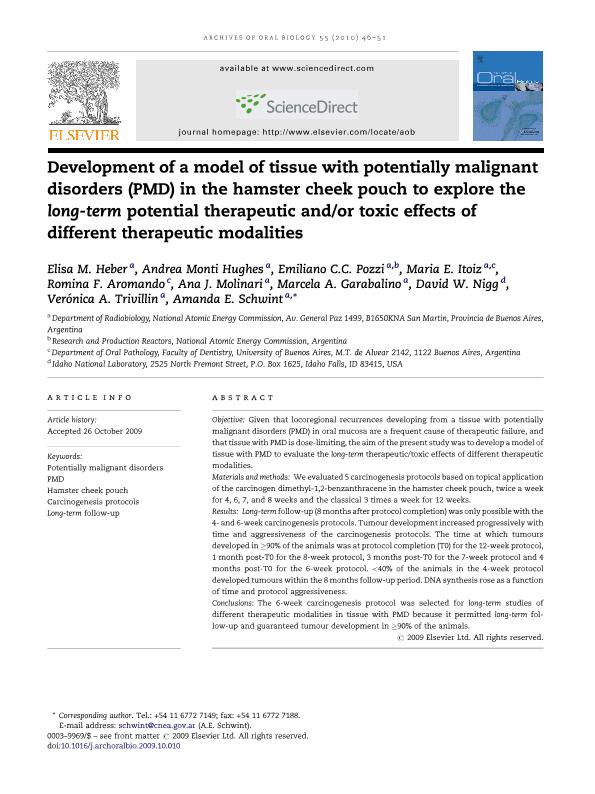Mostrar el registro sencillo del ítem
dc.contributor.author
Heber, Elisa Mercedes

dc.contributor.author
Monti Hughes, Andrea

dc.contributor.author
Pozzi, Emiliano César Cayetano

dc.contributor.author
Itoiz, María Elina

dc.contributor.author
Aromando, Romina Flavia

dc.contributor.author
Molinari, Ana Julia

dc.contributor.author
Garabalino, Marcela Alejandra

dc.contributor.author
Nigg, David W.
dc.contributor.author
Trivillin, Verónica Andrea

dc.contributor.author
Schwint, Amanda Elena

dc.date.available
2018-07-30T21:51:11Z
dc.date.issued
2010-01
dc.identifier.citation
Heber, Elisa Mercedes; Monti Hughes, Andrea; Pozzi, Emiliano César Cayetano; Itoiz, María Elina; Aromando, Romina Flavia; et al.; Development of a model of tissue with potentially malignant disorders (PMD) in the hamster cheek pouch to explore the long-term potential therapeutic and/or toxic effects of different therapeutic modalities; Pergamon-Elsevier Science Ltd; Archives of Oral Biology; 55; 1; 1-2010; 46-51
dc.identifier.issn
0003-9969
dc.identifier.uri
http://hdl.handle.net/11336/53550
dc.description.abstract
Objective: Given that locoregional recurrences developing from a tissue with potentially malignant disorders (PMD) in oral mucosa are a frequent cause of therapeutic failure, and that tissue with PMD is dose-limiting, the aim of the present study was to develop a model of tissue with PMD to evaluate the long-term therapeutic/toxic effects of different therapeutic modalities. Materials and methods: We evaluated 5 carcinogenesis protocols based on topical application of the carcinogen dimethyl-1,2-benzanthracene in the hamster cheek pouch, twice a week for 4, 6, 7, and 8 weeks and the classical 3 times a week for 12 weeks. Results: Long-term follow-up (8 months after protocol completion) was only possible with the 4- and 6-week carcinogenesis protocols. Tumour development increased progressively with time and aggressiveness of the carcinogenesis protocols. The time at which tumours developed in ≥90% of the animals was at protocol completion (T0) for the 12-week protocol, 1 month post-T0 for the 8-week protocol, 3 months post-T0 for the 7-week protocol and 4 months post-T0 for the 6-week protocol. <40% of the animals in the 4-week protocol developed tumours within the 8 months follow-up period. DNA synthesis rose as a function of time and protocol aggressiveness. Conclusions: The 6-week carcinogenesis protocol was selected for long-term studies of different therapeutic modalities in tissue with PMD because it permitted long-term follow-up and guaranteed tumour development in ≥90% of the animals.
dc.format
application/pdf
dc.language.iso
eng
dc.publisher
Pergamon-Elsevier Science Ltd

dc.rights
info:eu-repo/semantics/openAccess
dc.rights.uri
https://creativecommons.org/licenses/by-nc-sa/2.5/ar/
dc.subject
Carcinogenesis Protocols
dc.subject
Hamster Cheek Pouch
dc.subject
Long-Term Follow-Up
dc.subject
Pmd
dc.subject
Potentially Malignant Disorders
dc.subject.classification
Otras Medicina Básica

dc.subject.classification
Medicina Básica

dc.subject.classification
CIENCIAS MÉDICAS Y DE LA SALUD

dc.title
Development of a model of tissue with potentially malignant disorders (PMD) in the hamster cheek pouch to explore the long-term potential therapeutic and/or toxic effects of different therapeutic modalities
dc.type
info:eu-repo/semantics/article
dc.type
info:ar-repo/semantics/artículo
dc.type
info:eu-repo/semantics/publishedVersion
dc.date.updated
2018-07-30T15:41:51Z
dc.journal.volume
55
dc.journal.number
1
dc.journal.pagination
46-51
dc.journal.pais
Países Bajos

dc.journal.ciudad
Amsterdam
dc.description.fil
Fil: Heber, Elisa Mercedes. Comisión Nacional de Energía Atómica; Argentina
dc.description.fil
Fil: Monti Hughes, Andrea. Comisión Nacional de Energía Atómica; Argentina. Consejo Nacional de Investigaciones Científicas y Técnicas; Argentina
dc.description.fil
Fil: Pozzi, Emiliano César Cayetano. Comisión Nacional de Energía Atómica; Argentina
dc.description.fil
Fil: Itoiz, María Elina. Comisión Nacional de Energía Atómica; Argentina. Consejo Nacional de Investigaciones Científicas y Técnicas; Argentina. Universidad de Buenos Aires. Facultad de Odontología; Argentina
dc.description.fil
Fil: Aromando, Romina Flavia. Universidad de Buenos Aires; Argentina
dc.description.fil
Fil: Molinari, Ana Julia. Comisión Nacional de Energía Atómica; Argentina. Consejo Nacional de Investigaciones Científicas y Técnicas; Argentina
dc.description.fil
Fil: Garabalino, Marcela Alejandra. Comisión Nacional de Energía Atómica; Argentina
dc.description.fil
Fil: Nigg, David W.. Idaho National Laboratory; Estados Unidos
dc.description.fil
Fil: Trivillin, Verónica Andrea. Comisión Nacional de Energía Atómica; Argentina. Consejo Nacional de Investigaciones Científicas y Técnicas; Argentina
dc.description.fil
Fil: Schwint, Amanda Elena. Comisión Nacional de Energía Atómica; Argentina. Consejo Nacional de Investigaciones Científicas y Técnicas; Argentina
dc.journal.title
Archives of Oral Biology

dc.relation.alternativeid
info:eu-repo/semantics/altIdentifier/url/https://www.sciencedirect.com/science/article/pii/S0003996909002635
dc.relation.alternativeid
info:eu-repo/semantics/altIdentifier/doi/https://doi.org/10.1016/j.archoralbio.2009.10.010
Archivos asociados
